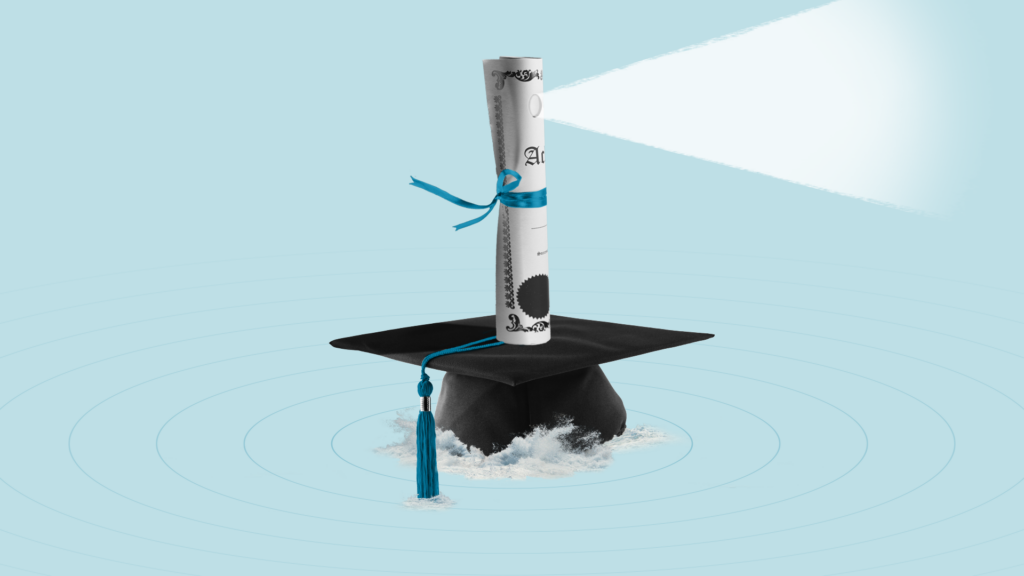Traditional methods of student recruitment are undergoing a profound transformation, caused in part by rapid digital advancements, shifting demographics, evolving student expectations, and changes to the skills most valued by employers. Educational institutions are coming up against a new reality in which they must adapt their recruitment strategies to remain competitive and relevant in attracting the next generation of learners.
Understanding the Changing Playing Field
As student demographics continue to evolve, it’s essential for institutions to understand the shifting landscape of the populations these learners come from. Research on student-centric campuses sheds some light on the changing demographics affecting higher education: shifts in age, socioeconomic status, and geographic location show increasing diversity among students, but the rise of adult learners and non-traditional student segments is significant, too, and emphasizes the need for tailored recruitment strategies. Making things even trickier is the fact that every demographic—and sometimes every student—comes with their own unique needs and preferences that institutions must address in order to effectively attract and retain them.
Demographics aren’t the only thing changing the game. The digital revolution has fundamentally altered not only the populations of these students but also the way they choose to engage with educational institutions. At every point—from initial exploration to enrollment—digital channels play a pivotal role in their recruitment journey.
Deloitte’s CMO survey offers valuable insights into the investments made by higher ed marketers and where they place their digital priorities, and one thing is clear: there’s no understating the importance of leveraging digital technologies in reaching and engaging prospective students effectively. Social proof and influencer marketing have become industry norms, and both are expected to grow by more than 100 percent in the next few years. Marketing teams are choosing to cut out intermediary channel partners and go straight to market themselves. Marketing and sales are closely aligning strategies and goals and spending dramatically more on digital.
A recent blog post by Hannon Hill about web trends in higher ed highlights the significance of accessibility and mobile optimization and calls out eight trends to watch this year: generative AI, content personalization, search engine optimization (SEO) and the use of voice search assistants, short-form and live streaming videos, podcasts, PR and thought leadership to establish credibility, using faculty and SMEs as micro-influencers, and reusing high-performing modular content. All can—and should—be considerations for a reimagined approach to recruitment.
It’s imperative for institutions to embrace these trending tools, technologies, and strategies if they want to create the seamless and engaging digital experiences that resonate with today’s digital natives. Their increased preference for and dependence upon smartphones and tablets means mobile optimization is crucial for reaching and engaging students on-the-go, and personalization of content tailored to their individual preferences (delivered when, where, and how they want to engage with it) enhances the overall recruitment experience and fosters stronger connections with prospective learners.
Solving for Digital and Demographic Shifts
In response to these seismic shifts to the landscape of recruitment, institutions have a number of promising strategies to pull from to create engaging touchpoints for their prospects. Let’s look at these broadly in combination with what we’ve already talked about:
Enhanced Personalization and Engagement
Harnessing the power of artificial intelligence (AI) and data analytics enables institutions to deliver personalized communication tailored to the preferences and behaviors of their prospective students. Analysis of data points including browsing history, interactions, and demographics can help schools craft targeted messaging that resonates with individual learners.
Additionally, Customer Relationship Management (CRM) systems offer universities a centralized platform for tracking and managing their interactions with prospective students. By capturing and analyzing this data throughout the recruitment process, schools can gain insights into a student’s engagement level and preferences, allowing for more effective communication and follow-up.
And while less common, marketing automation software adds efficiency to the CRM process, automating marketing email, social media, and analytics so that CMOs save time and increase productivity. But use of automation is growing, especially among universities with marketing leadership—those schools are 78% more likely to use marketing automation than those without CMOs.
A Student-Centric Approach
Adapting to and embracing a student-centric model is another important part of meeting students’ evolving needs. This doesn’t mean merely considering students during strategy and planning sessions, it means placing students and their needs and expectations at the very center of planning and strategizing efforts.
In a session I moderated at the 2024 Annual UPCEA Conference, we talked about the impact that the recent pandemic had on international students; specifically that their need to change and adapt was just a part of the educational experience. As the session continued, it became clear to me that those of us on the provider side often use the words “educational experience” to describe one thing.
But what if we parsed it? I asked the panel a question:
“We’ve talked a lot about the experience, but has anything about the education itself changed?”
Light bulbs went on around the room—myself included. For students, educational content hasn’t changed much; it’s all about the experience changing. That’s where—and why—student-centricity shines: it changes the core experience for your students.
Learners increasingly want personalization, flexibility and options when it comes to education. Prioritizing their success and satisfaction by providing tailored support services, academic advising, and campus resources fosters a sense of belonging and connection among students, enhancing their overall experience. It transcends the recruitment process and includes their day-to-day experience with your schools and programs. Rather than prescribing what they should do, institutions must provide an environment that allows them to reach their goals and objectives in the ways that best suit them.
As demographics continue to shift, universities will need to revise messaging and communication channels to effectively reach diverse student populations. This can involve the adoption of inclusive language, use of culturally relevant content, and maintaining a variety of communication platforms (e.g., social media, email, and instant messaging apps) to engage with prospective students.
Content and Digital Marketing
Content marketing is a powerful tool for engaging potential students. Compelling storytelling through content such as blog posts, videos, and infographics can be used to highlight a school’s unique offerings, faculty expertise, and campus culture, regardless of whether learners’ touchpoints are on the Quad, on a call, or online. By providing insights and resources on the channels on which students choose to engage with you, institutions can establish themselves as thought leaders in their field and attract the students and populations they’re most interested in recruiting.
With the proliferation of these digital channels, institutions must invest in marketing strategies that rely heavily on them in order to effectively reach their audience. This includes targeted campaigns on platforms such as Google Ads, Facebook, Instagram, TikTok, and LinkedIn, as well as search engine optimization (SEO) to improve visibility in online searches. Putting a heavy emphasis on these channels can help increase brand awareness, drive website traffic, generate leads, and ultimately improve your recruitment numbers.
Of course with any of these strategies, a major component of their success is having the right people involved. Internal advocates, faculty and staff, and especially the institutional CMOs tasked with setting and spearheading the school’s digital marketing priorities become a critical part of the process.
The Right Technology for Analytics and Insights
As mentioned above, universities are increasingly turning to emerging technologies to gain deeper insights into student preferences and behaviors, enabling more informed recruitment strategies and decision-making. Institutions in the know have already begun exploring the potential of emerging technologies such as artificial intelligence (AI), machine learning, and predictive analytics to gain deeper insights into student preferences and behaviors. The vast amounts of data these technologies analyze can uncover patterns, trends, and correlations that provide valuable insights into students’ motivations and interests, as well as the likelihood they’ll enroll.
It’s important not to underestimate the role of data in shaping marketing strategies and recruitment efforts. That mindset is gaining steam among higher ed professionals; nearly 30 percent want their CMOs to prioritize marketing that directly addresses improving enrollment and fundraising. Collecting and analyzing data from website traffic, social media interactions, and enrollment trends can identify areas of opportunity, track campaign effectiveness, and optimize recruitment efforts—often down to the individual student—in real-time.
It’s plain to see that this level of tech-driven analytics and insights can give institutions a deeper understanding of their target audience, inform their recruitment strategies, and ultimately enhance student enrollment outcomes.
The Revolution Isn’t Coming—It’s Already Here
Changing demographics and digital advancements will continue to reshape the landscape of student recruitment in higher education, so it’s only natural that the institutions embracing these changes and investing in digital technologies and strategies will be best positioned to attract and retain the next generation of learners. It’s essential for higher education institutions to remain agile and innovative in their marketing strategies, leveraging emerging technologies and embracing diversity and inclusion to effectively engage with prospective students. By staying ahead of the curve and adapting to evolving trends, institutions can ensure their continued success in recruiting and retaining students.
Kevin Phang is VP, Partnership Development, Marketing & Enrollment for Noodle. Noodle is the leading tech-enabled strategy and services partner for higher education. A certified B corporation, Noodle (founded in 2013) has developed infrastructure and online enrollment growth for some of the best academic institutions in the world. Noodle empowers universities to transform the world through life-changing learning. It offers strategic consulting to advise partners as they navigate their futures, provides services tailored to meet their growth aspirations, and deploys technology, tools, and platforms that integrate for scale, making our partners more resilient, responsive, efficient, and interconnected. Noodle.com
References
“Reshaping the student experience – The role of technology in enabling student-centricity,” Deloitte, 2023.
“The case for a student-centric campus: Colleges and universities must centre on student needs,” Deloitte.
Chris Lucas, “Top 4 Digital Priorities for Higher Ed CMOs,” Convince & Convert.
Val Fox, “Our New Staffing Model Playbook for Higher Ed CMOs,” EAB, January 22, 2024.
Kat Liendgens, “8 Higher Education Web Trends to Watch in 2024,” Hannon Hill, December 14, 2023.
“Top trends from The CMO Survey,” Deloitte, 2023.



